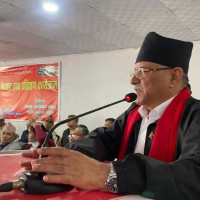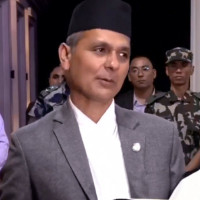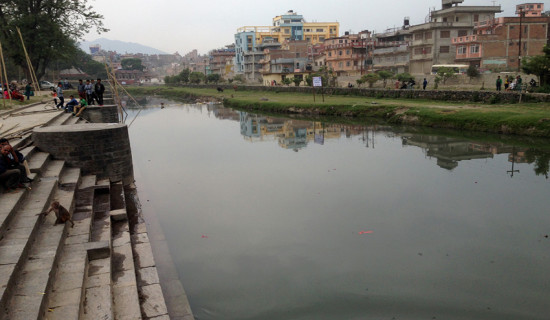- Sunday, 26 October 2025
Economy Grows By Leaps And Bounds
The country embarked on a new political and economic journey by establishing a republic system and abolishing the 240-year monarchical rule in 2008. The epoch-making political change naturally increased the people's expectations for inclusive development in the country. Notable progress has been made in the economic sector over the years. The size of the gross domestic product (GDP) has increased by seven and a half times after the country was declared a republic 17 years ago,
Yet, the economic growth rate remained at an average of 4.5 per cent in the early years. A lack of investment in the productive sector, structural constraints, and the absence of sustainable policies are significant causes of this slow-paced growth. The 2015 earthquake and the COVID-19 pandemic also halted growth momentum. "Although some policy, systemic, and procedural efforts have been initiated to improve the economy, the results have not been as expected," said Dr. Chandra Mani Adhikari.
Expansion of national economy
According to the National Statistics Office, Nepal's economy is estimated to reach Rs. 6,107 billion in the current fiscal year 2024/25. In the fiscal year 2007/08, GDP's size at the purchaser's price was Rs. 820 billion. The current fiscal year's budget is around Rs. 1,860 billion. It was Rs. 169 billion in the fiscal year 2007/08. Likewise, the gross national income per capita is estimated at USD 1,517 in the current fiscal year 2024/25 from approximately USD 441 in 2007/08.
The growth is estimated at 4.61 per cent in the current fiscal year 2024/25 at purchasers' price, which was around 5.3 per cent in the fiscal year the country became a republic. The economic growth rate was limited to 0.6 per cent in fiscal year 2015/16 when the massive earthquake jolted central Nepal, but it increased to 8.2 per cent in fiscal year 2016/17 and 6.7 per cent in 2017/18.
In the current fiscal year, the agricultural sector is estimated to grow by 3.28 per cent and the non-agricultural sector by 4.28 per cent. Observation of the structure of GDP shows that the primary, secondary, and service industries are estimated to contribute 25.6 per cent, 12.4 per cent, and 62 per cent, respectively. Economist Keshab Acharya said that the country saw positive growth in the energy, financial sector, insurance, and capital market, contributing to the economic growth. Nepal has been trying to make maximum use of its hydropower resources, and the installed hydropower capacity reached around 3,500 MW at present.
The information and communication technology (ICT) sector has experienced rapid growth, revolutionising how Nepalis interact with their fellow citizens, learn, and do business. Similarly, significant progress has been registered in exports in the current fiscal year. Exports have surged by 72.71 per cent to Rs. 217.91 billion by mid-May 2025, while import trade increased by 13.11 per cent to Rs. 1,474.18 billion. Due to a low volume of exports compared to imports, the country's trade deficit soared to Rs. 1,256.27 billion during the review period.
Remittance reduces poverty
In the meantime, remittances contribute to Nepal's foreign exchange reserves, bolstering the country's ability to manage imports, stabilise currency fluctuations, and meet external debt obligations. The contribution of remittance to GDP reached 25.41 per cent in fiscal year 2023/24, while it was 17.4 per cent in 2007/08. Nepal received remittance of Rs.142.68 billion in fiscal year 2007/08, which increased to Rs. 1,191.31 billion in the first 10 months of the current fiscal year. Over 50 per cent of households depend on remittance income, vital in reducing poverty and income inequality. Poverty rates were reduced to 20.27 per cent in 2023 from 25.16 per cent in 2011.
The foreign currency reserves reached an all-time high of Rs. 2,426.84 billion during the first nine months of the current fiscal year. With the increasing size of the economy, national debt has also swelled. To meet the budget deficit, the government has been compelled to take on debt to manage the expenditure, resulting in the skyrocketing public debt that has grown seven times in the last 17 years. Nepal's total outstanding public debt reached Rs. 2,622.40 billion as of mid-May 2025, while it was about Rs. 361 billion in the fiscal year 2007/08. The total debt to GDP ratio is now 42.94 per cent.
The devolution of powers has allowed rural areas to develop more efficiently using local resources and federal financial support. Citizens also benefit from proximity to government services, with ward offices serving as convenient access points for various facilities, saving time and cost for the people. Local governments have focused on road construction, water supply, education, and health sectors, spurring socio-economic development. Dr Adhikari highlights the transformative role of federal funds in fuelling rural development, "There is no single municipality where funds of at least Rs. 20 million to Rs. 30 million have not been reached." Good infrastructures such as schools, rural municipality offices, ward offices, and health posts have been built. However, due to the lack of a qualified workforce and necessary equipment, health posts cannot provide quality health services.
Focus on revenue collection
The failure to expand manufacturing industries has resulted in massive unemployment, forcing the youth to migrate abroad for better livelihood prospects. An import-based economy has deepened dependency, hurting development and prosperity. Similarly, revenue collection is not up to the mark, as expenditures are rising yearly. The elected officials must prioritise revenue mobilisation instead of demanding more allocation. Likewise, low capital budget expenditure has also prevented the government from achieving the targeted economic growth.
While there has been significant improvement in some indicators, many areas still require improvement. A long-term inclusive policy and strategy need to be executed to focus on the productive sector. Political stability, policy consistency, and capacity building are vital for inclusive growth and shared prosperity.
(Kafle is a reporter at The Rising Nepal.)
















